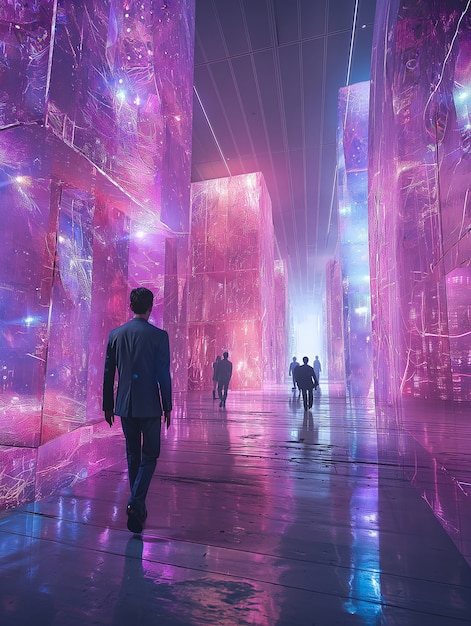The Metaverse’s Next Chapter: Driving Adoption in the US Market

The Metaverse’s Next Chapter: What’s Driving Adoption in the US Market? explores how advancements in technology, gaming, social interaction, and digital commerce are fueling the metaverse’s increasing acceptance and integration into US users’ daily lives.
The Metaverse’s Next Chapter: What’s Driving Adoption in the US Market? is a question on many minds. What forces are pushing this virtual world into the mainstream, and how are US consumers embracing this technology?
Understanding the Metaverse: A Quick Recap
Before diving into the driving forces behind metaverse adoption in the US, it’s crucial to understand what the metaverse truly is. It’s more than just virtual reality; it’s an evolving digital realm where users can interact, work, play, and even transact.
The metaverse represents a convergence of physical and digital life, blurring the lines between the two. It’s a space where persistent virtual worlds, augmented reality, and the Internet of Things intersect to create immersive experiences.
Key Features of the Metaverse
The metaverse is characterized by several key features that distinguish it from traditional online experiences. These include:
- Persistence: The metaverse exists continuously, even when individual users are not actively engaged.
- Interactivity: Users can interact with each other and the virtual environment in real-time.
- Immersion: Technologies like VR and AR create a sense of presence and immersion within the metaverse.
- Social Interaction: The metaverse facilitates social connections and communities through shared experiences.
The metaverse represents a new frontier in digital interaction, offering a multitude of opportunities for businesses and individuals alike to engage, create, and connect in unprecedented ways. As technology continues to evolve, so too will the metaverse, promising even greater levels of immersion and integration in the future.

Technological Advancements Fueling Metaverse Growth
One of the primary drivers behind metaverse adoption in the US is the rapid advancement of the core technologies that power it. These advancements are making the metaverse more accessible, immersive, and user-friendly.
From improved VR headsets to faster internet speeds, technological progress is laying the foundation for a more seamless and engaging metaverse experience.
The Role of VR and AR
Virtual reality (VR) and augmented reality (AR) are central to the metaverse experience. Recent advancements in these technologies have significantly enhanced the sense of immersion and presence within virtual worlds.
- Improved Headset Technology: VR headsets are becoming more powerful, lighter, and more affordable, making them accessible to a wider audience.
- Enhanced AR Capabilities: AR technology is being integrated into smartphones and other devices, allowing users to seamlessly blend digital content with their physical surroundings.
- Spatial Computing: Advancements in spatial computing are enabling the creation of more realistic and responsive virtual environments.
These technological advancements are not only improving the user experience but also opening up new possibilities for metaverse applications across various industries, from gaming and entertainment to education and healthcare. The ongoing development of these technologies will continue to drive metaverse adoption in the US market.
Gaming and Entertainment: A Gateway to the Metaverse
The gaming and entertainment industries have played a pivotal role in introducing the metaverse concept to a wider audience. Popular games like Fortnite and Roblox have already created virtual worlds where millions of users gather to play, socialize, and attend virtual events.
These platforms serve as a natural entry point into the metaverse, familiarizing users with the concept of virtual avatars, digital economies, and shared online experiences.
Metaverse-Integrated Games
Several game developers are actively building metaverse-integrated games that offer players a more immersive and persistent virtual world. These games often feature:
- User-Generated Content: Players can create and share their own content within the game world, fostering a sense of community and creativity.
- Digital Ownership: Players can own and trade virtual assets, creating a real-world economic value within the game.
- Cross-Platform Compatibility: Players can access the game from various devices, creating a seamless and interconnected metaverse experience.
The gaming and entertainment sectors are poised to continue driving metaverse adoption in the US. By offering engaging and immersive experiences, these industries are paving the way for a future where the metaverse becomes an integral part of our daily lives.

Social Interaction and Community Building in Virtual Spaces
The metaverse offers new opportunities for social interaction and community building that transcend geographical boundaries. Virtual spaces provide a platform for people with shared interests to connect, collaborate, and form meaningful relationships.
From virtual concerts and conferences to online support groups and language exchange programs, the applications for social interaction in the metaverse are vast and varied.
Benefits of Social Interaction
Social interaction in the metaverse offers several benefits, including:
- Enhanced Connectivity: People can connect with others from around the world, fostering a sense of global community.
- Increased Accessibility: The metaverse provides a platform for people with disabilities or limited mobility to participate in social activities.
- New Forms of Expression: Users can express themselves through virtual avatars and digital creations, fostering creativity and self-discovery.
The metaverse has the potential to revolutionize social interaction and community building, offering new ways for people to connect, collaborate, and form meaningful relationships. This shift is particularly appealing to younger generations who are already comfortable with digital communication.
Digital Commerce and the Metaverse Economy
The metaverse is creating new opportunities for digital commerce and economic activity. Virtual marketplaces, digital storefronts, and in-world advertisements are becoming increasingly common, generating new revenue streams for businesses and creators.
The rise of non-fungible tokens (NFTs) has also played a significant role in the development of the metaverse economy, enabling the ownership and trading of unique digital assets.
Opportunities for Businesses
Businesses are leveraging the metaverse for various purposes, including:
- Virtual Product Sales: Companies are selling virtual versions of their products within the metaverse, allowing users to personalize their avatars and virtual spaces.
- Virtual Events and Marketing: Brands are hosting virtual events, concerts, and conferences to reach a wider audience and promote their products.
- Advertising and Sponsorships: Companies are placing ads and sponsoring virtual events within the metaverse, generating brand awareness and revenue.
The metaverse economy is still in its early stages, but it has the potential to transform the way businesses operate and interact with consumers. As the metaverse continues to evolve, we can expect to see even more innovative and creative applications for digital commerce.
Infrastructure and Accessibility Challenges
While the potential of the metaverse is enormous, there are still significant challenges that need to be addressed to ensure widespread adoption in the US market. One of the primary challenges is the need for robust infrastructure and improved accessibility.
High-speed internet access, affordable VR headsets, and intuitive user interfaces are essential for creating a seamless and engaging metaverse experience for all users.
Addressing Infrastructure Needs
To overcome these challenges, stakeholders need to invest in:
- Broadband Expansion: Expanding access to affordable and reliable high-speed internet across the US.
- Hardware Affordability: Reducing the cost of VR and AR headsets to make them accessible to a wider audience.
- Software Optimization: Developing user-friendly software and interfaces that are easy to navigate and understand.
By addressing these infrastructure needs and accessibility challenges, we can ensure that the benefits of the metaverse are available to everyone, regardless of their location, income, or technical skills. This is essential for creating a truly inclusive and equitable metaverse experience.
| Key Aspect | Brief Description |
|---|---|
| 🚀 Tech Advancements | VR/AR improvements drive immersive experiences. |
| 🎮 Gaming Influence | Games like Fortnite introduce metaverse concepts. |
| 🌍 Social Connections | Metaverse fosters communities beyond physical limits. |
| 💰 Metaverse Economy | NFTs and virtual marketplaces drive economic growth. |
Frequently Asked Questions (FAQ)
▼
The metaverse is a network of 3D virtual worlds focused on social connection. Think of it as a digital extension of reality where you can interact with others, explore environments, and even buy or trade goods and services.
▼
VR and AR are key technologies that provide immersive and interactive experiences in the metaverse. VR creates completely virtual environments, while AR overlays digital elements onto the real world, enhancing real-time experiences.
▼
Gaming acts as a gateway to the metaverse, familiarizing users, especially younger audiences, with virtual environments, avatars, and digital interactions. Games like Roblox and Fortnite are already metaverse-like platforms.
▼
Key challenges include the need for better internet infrastructure, affordability of VR/AR headsets, and user-friendly interfaces. Accessibility and equity are also crucial for making the metaverse inclusive for everyone.
▼
Businesses can leverage the metaverse for virtual product sales, hosting virtual events, marketing campaigns, and even remote training simulations. These applications offer new ways to engage with customers and generate revenue.
Conclusion
The metaverse is continuing its evolution in the US market, driven by various factors like technological advancement, gaming and entertainment influence, enhanced social interactions, and digital commerce. Addressing infrastructure and accessibility challenges remains crucial to ensuring that the metaverse is open and available to all users.
